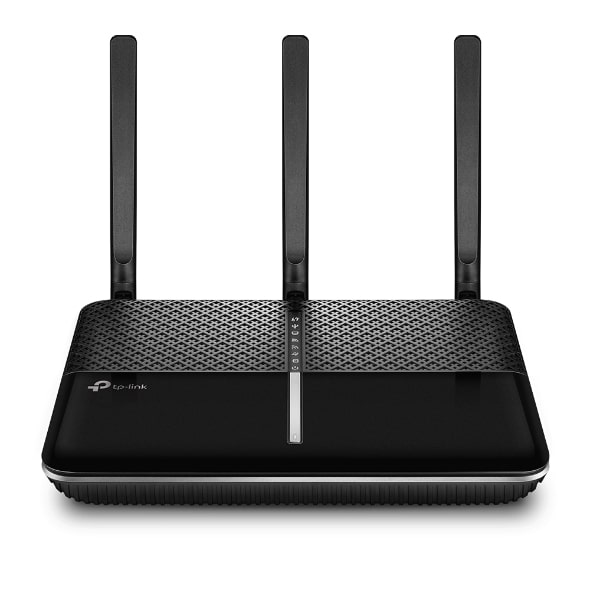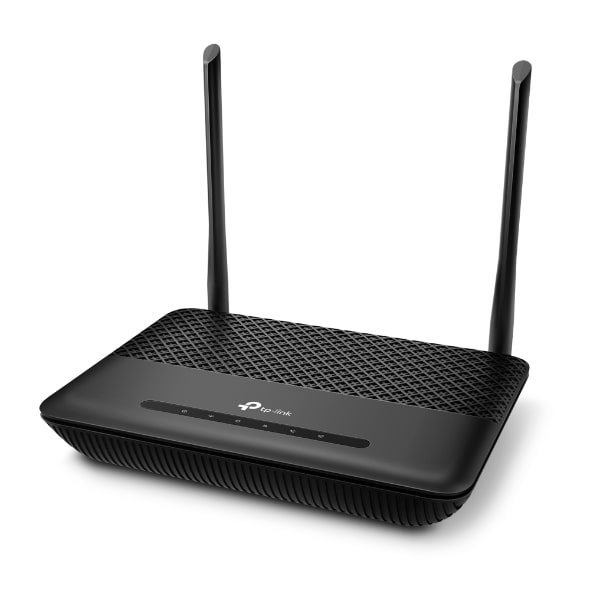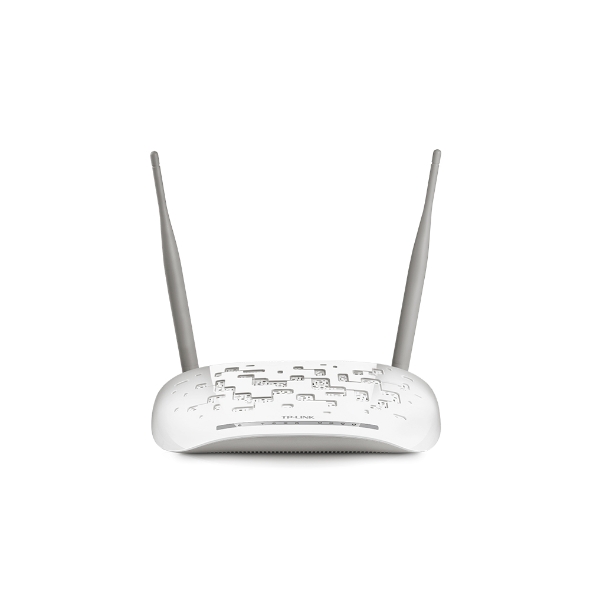TP Link Archer VR600 AC2100 Wireless MU-MIMO VDSL/ADSL Modem Router
$158.93
TP Link Archer VR600 features Super VDSL (VDSL2 Profile 35b), the latest generation of DSL technology. Downstream is increased by up to 350 Mbps, 3.5x faster than its VDSL2 predecessor. Compatibility with the leading ISPs including Telekom, 1&1 and Vodafone provide ideal IP-based connections for any home. The integrated DSL port also supports all standard DSL connections
TP Link Archer VR600 Modem Router Feature:
Super VDSL— The Newest Super VDSL (VDSL2 Profile 35b) tech delivers internet speeds of up to 350 Mbps
Ultra-Fast Speed— Surpasses the Wi-Fi speed limits of the previous generation, reaching up to 1733 Mbps on 5 GHz and 300 Mbps on 2.4 GHz
4 × 4 MU-MIMO— Simultaneously transfers data to numerous devices for 4x faster performance
Whole-Home Coverage with OneMeshTM– Co-works with TP-Link OneMesh products to create a flexible and cost-efficient Mesh network
Lightning-Fast Wired Connection– USB 3.0 port and four Gigabit Ethernet ports run up to 10x faster than the previous generation to unleash your home entertainment
TP-Link Tether App— Simply access and handle your network, including remote control and automatic updates, using any iOS or Android mobile device.
Where To Buy TP Link Archer VR600 Router:
TP Link Archer VR600 Modem Router Spec:
| Ports | 3 Gigabit LAN Ports, 1 Gigabit LAN/WAN Port, 1 RJ11 Port, 1 USB Port |
| IEEE Standards | IEEE 802.3, IEEE 802.3u, 802.3ab |
| VDSL2 Standards | ITU G.993.2, Up to 35b profile (POTS) ITU-T G.993.5 (G.vector) ITU-T G.998.4 (G.INP) |
| ADSL Standards | Full-rate ANSI T1.413 Issue 2, ITU-T G.992.1(G.DMT), ITU-T G.992.2(G.Lite), ITU-T G.994.1 (G.hs) |
| ADSL2 Standards | ITU-T G.992.3 (G.DMT.bis), |
| ADSL2+ Standards | ITU-T G.992.5 |
| Antenna Type | 3 External Dual Band Antennas + 1 Internal 5 GHz Antenna |
| Wireless Standards | IEEE 802.11ac/n/a 5 GHz, IEEE 802.11b/g/n 2.4 GHz |
| Frequency | 2.4 GHz and 5 GHz |
| Signal Rate | 1733 Mbps on 5 GHz, 300 Mbps on 2.4 GHz |
| Transmit Power | <20dBm (2.4 GHz), <23dBm (5 GHz) |
| Wireless Functions | Enable/Disable Wireless Radio, Wireless Statistics |
| Wireless Security | 64/128-bit WEP, WPA/WPA2, WPA-PSK/WPA-PSK2 |
| encryptions | |
| Wireless Schedule | Support 2.4 GHz and 5 GHz Wireless Schedule |
| Package Contents | DSL Modem Router External Splitter RJ11 DSL Cable RJ45 Ethernet Cable Power Adapter Quick Installation Guide |

TP Link Archer VR600 Modem Router Reviews:
The TP-Link VR600v is a budget-friendly device, so it will only have some features to improve the wireless performance and the most prominent one is the Advanced BeamForming which has the role of focusing the signal directly towards the clients which are connected via WiFi rather than broadcasting it anywhere (be aware that to take advantage of this technology, the wirelessly linked clients need to have compatible WiFi adapters). Thus, if you need the MU-MIMO tech (useful only if you’re able to get your hands on devices with high-end WiFi adapters), the NitroQAM (1024QAM) technology or the 160MHz Aggregation, then you may be better off checking the more expensive TP-Link VR2800v.
Furthermore, the VR600v won’t be able to become a node inside a mesh network and, although TP-Link decides to create something like the AiMesh technology, it still won’t be compatible, thus, if you have a large home and need a mesh system, then you can run the VR600v in modem mode only (to do so, you need to create a new WAN interface by going to the Network > Internet tab > Add > Connection Type > Bridge and afterwards, disable the DHCP and both the 2.4 and the 5GHz radio bands). In this manner, you will be able to add any other WiFi mesh system and if you’re fond of the TP-Link environment, you could give a try the dual-band Deco M5 or wait a bit and go for the newer tri-band Deco M9.
But the VR600v is much more than just a wireless router + DSL modem, it also has VoIP support built-in, so using the included DECT station, you can add two analogue handsets and six cordless phones or fax machines (at the same time, it comes with 270 minutes Voice Mail). The VR600v also permits you to link any smartphone to the modem router, so you can make land-line calls, verify messages or missed calls or check out the PhoneBook contacts when you are not at home.
The TP-Link VR600v supports three Operational Modes, the first is the VDSL/ ADSL Modem Router Mode, the second is 3G/ 4G Router Mode and the third is the Wireless Router Mode. Using the first Mode (I used the device with a VDSL connection), I figured a max of 75 Mbps, which is the actual max I can get on that line (tested by the ISP technician), so the modem router can draw the maximum available speed. If you keep the VR600v in this mode, then your linked devices will receive as high as 100 Mbps (capped by the DSL port) and you can enjoy around 1000 Mbps only in the LAN. The good news is, this device can also connect to a FTTH fibre connection, so you can increase to 1Gbps.
Now, in order to test the wireless performance I took two computers, one is a high-end laptop that gets linked to the modem router via a 1Gbps cable (the server) and the second is a computer outfitted with one of the best wireless adapters available today (the Asus PCE AC88)– the client. In this manner, I could accurately measure the ideal performance that the VR600v can deliver at various spots inside the home. Thus, using the 5GHz radio band (802.11 ac standard), at 5 feet, I can measure an average of 516 Mbps, while at 15 feet, the speed went slightly down to 430 Mbps and lastly, at 30 feet, I measured an average of 328 Mbps.
On the next step, I decided to switch to the 2.4 GHz network and, using a compatible wireless client, I measured an average of 96.6 Mbps at just 5 feet from the router, while at 15 feet, I measured about 85.6 Mbps. At 30 feet, the speed remained reasonably consistent and I checked out an average of 76.8 Mbps. The wireless speed performance on the 5GHz band was amazingly great, however, if you want to use devices from the older WiFi standard (802.11 n 2.4 GHz), the performance is nothing to brag about.
Final:
I know that 2022 remains the year of WiFi mesh systems, but the TP-Link VR600v came as a surprise on many fronts: the wireless performance on the 5GHz WiFi network was way above average considering its price tag (at the same time, the performance on the 2.4 GHz WiFi network was underwhelming) and the web-based user interface will satisfy the tech-savvy people, while the Tether app should be enough for people that don’t really take care of an in-depth configuration. Obviously, it has its flaws, such as the aforementioned 2.4 GHz performance, the slight overheating problem and the lack of a USB 3.0, however all of these don’t outweigh the positive points, so the Archer VR600v remains a great budget-friendly solution for small-to-medium homes which are still stuck to the DSL lines.










Floyst –
Within 30 minutes I have set up the archer vr600 router, moved the TV, Sonos, hue, Alexa and iPhones to the new WiFi and tested signal on all 3 floors.
So far this is an absolute dream and I can’t believe it doesn’t have better reviews.